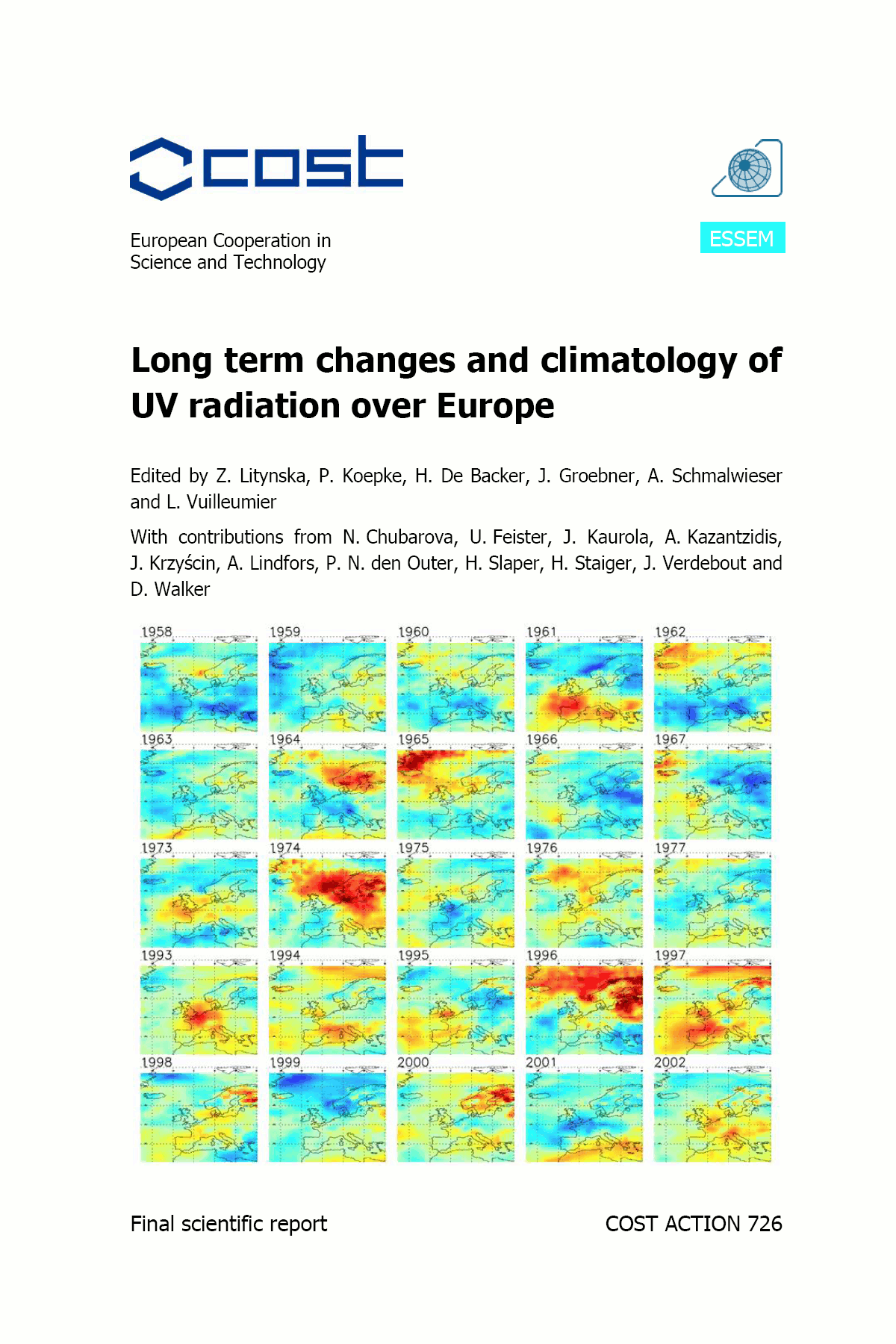

INTRODUCTION
Solar UV radiation plays an essential role in many biological and chemical processes, including
sunburn, skin cancer and effects on the human immune system. UV radiation may be very harmful if its
exposure exceeds certain limits. Since Europeans live under very different meteorological conditions and
many UV-effects have a long incubation time, it is of interest to know the changes of UV radiation in
space and time for Europe. Moreover, the changes of the solar UV irradiance during the last 50 years are
of interest with respect to the well known evolution of the ozone layer and the general variation of
climate.
Download
Last Update: April 2010,
Thus the COST action 726 “Long term changes and climatology of UV radiation over Europe” has
been established, with the main objective to advance the understanding of UV radiation distribution under
various meteorological conditions in order to determine a UV radiation climatology and assess UV
changes over Europe.
This report starts with the methods which have been used for UV reconstruction (see chapter 2), i.e.
model calculations using values of the atmospheric and surface constituents as input parameters that are
influencing UV radiation. The question, how to get values for the input parameters, which are needed for
5 decades in the past and for the wide area of Europe, is discussed in chapter 3. Chapter 4 presents
information on UV measurements, which are necessary to evaluate the quality of the modelling. The
quality of the results and their uncertainty due to the uncertain or not available input parameters is
presented in chapter 5. Here also results are shown which represent UV radiation modelled with other
data sets. The results, the UV radiation in the past, for nearly a half century back, are the content of
chapter 6. They are shown as time series for individual stations (6.1) and as maps for whole Europe (6.2),
for an area between 30.5° north to 80.5° north and 25.5° west to 35.5° east, with a spatial resolution of
0.05° × 0.05°. The temporal changes of the UV irradiance in Europe are discussed in section 6.3.
As usual, the presented data for UV radiation are based on erythemal spectral weighting, i.e. they are
valid for UV radiation that is responsible for sun burn and dominantly for skin cancer. With respect to
temporal resolution, the data have been modelled as daily doses, which is a compromise between the
temporal resolution of the available input data and that which is needed to investigate UV-processes on
humans. Results with such high temporal resolution, however, may be uncertain due to the uncertainty of
the atmospheric data like cloudiness (see sections 5.2 and 5.3). Thus the results are shown as monthly
mean values of the daily doses. For a number of stations the results are compared with measured data, to
get an idea of the quality of the results (see section 6.1) and to show the evolution with higher temporal
resolution. Since UV radiation has many other biological effects besides sunburn, UV radiation is
presented in section 6.4 for other biological processes besides erythemal weighting.
For distributing the huge amount of information developed by the COST action 726, an electronic
atlas including all the erythemal data is available in addition to this report. Data are provided together
with a computer program which enables extracting data for a certain location over a certain period.
Appendix E describes how to use this program.
The results of COST action 726 give detailed information on the temporal changes of UV in Europe
in nearly half a century, mainly due to changes of ozone and clouds. They give the possibility to see
different behaviour in different areas and in different years. Thus, the results are a fundamental basis for
further research on UV effects.
The report has been written by leader authors, but it is a result of the collective efforts of the
members of the four Working Groups, coming from 22 EC COST countries and one non-COST country,
and of the Management Committee. For details and further information on the action see
www.cost726.org. This publication is supported by COST.
The Final Report is available in two resoultions:
Final Report Cover (pdf, 1 MB)
Final Report Part I (pdf, 5 MB)
Final Report Part II (pdf, 4 MB)
Final Report Part III (pdf, 6 MB)
by A.W.Schmalwieser